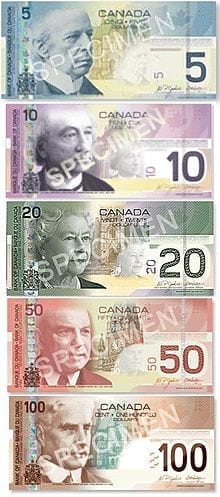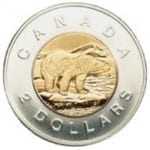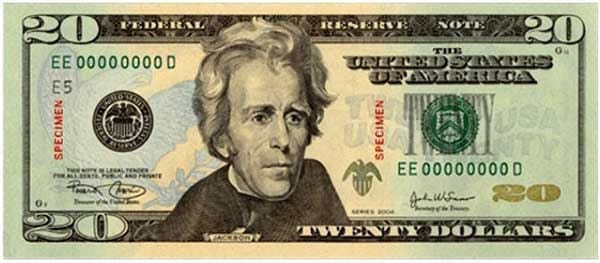Currency Exchange Rates
Below are the types of currency you will typically use in the United States and Canada. Although most of the pieces have similar names, their values are different. Exchange rates change by the minute, but you can use the currency calculator below to get current prices. You will typically find you receive the best exchange rates from a bank or ATM machine.
Canada uses the following types of common coins:
- 1¢ penny – no longer in production, but still accepted as legal tender
- 5¢ nickel
- 10¢ dime
- 25¢ quarter
- 50¢ piece – rarely used
- $1 loonie coin
- $2 toonie coin

Canadian paper bills are brightly colored, making them easy to distinguish from one another. These include:
- $5 bill
- $10 bill
- $20 bill
- $50 bill
- $100 bill
Near the border, you will find many places that will accept U.S. dollars, but the exchange rates may not be very good. It is therefore a good idea to convert at least some currency at a bank before your trip. Banks in both countries will almost always give you the best exchange rate.
If you decide to pay for something in American dollars, you should compute the exchange rate you are getting, as businesses can charge you whatever they want for this service. You will sometimes find currency-exchange storefronts in tourist destinations, but the exchange rate can be poor and surcharges are unpredictable.
One final consideration: If you are quoted a hotel rate in American dollars, but you make payment when you check out of the hotel, you will again face the exchange rate surcharge. The hotel will charge you in Canadian dollars and can use any rate they wish to compute how much you owe. This maybe true even if you use a credit card. Make sure you understand exactly how much the hotel will charge you at the time you make your reservation. You should consider paying for the room online before you arrive, or be prepared to pay the entire sum in American cash.
American Money

Below are the most commonly used denominations of U.S. Currency. Most ATM machines will dispense $20 bills.
- 1¢ penny
- 5¢ nickel
- 10¢ dime
- 25¢ quarter
- $1 bill
- $5 bill
- $10 bill
- $20 bill
- $100 bill
Credit and Debit Cards
Presuming you have an acceptable credit or debit card, these are frequently a good way to pay for things. Generally speaking, you tend to get better exchange rates using a debit card at an ATM than when you try to get cash at a hotel or even a bank. However, check with your card issuer before you leave to find out how the exchange rate will be computed and what additional fees may be applied. You should also alert them to your trip, as the first charge in another country can trigger a fraud alert. You will know this has happened if you find you card is suddenly being denied. You can fix this by making a call to your credit card issuer, but this can take some time and leave you without any way to pay for things.

